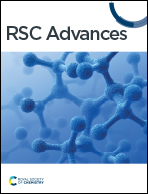Anisotropic hydrogel fabricated by controlled diffusion as a bio-scaffold for the regeneration of cartilage injury†
Abstract
Controlled fabrication of anisotropic materials has become a hotspot in materials science, particularly biomaterials, since the next generation of tissue engineering is based on the application of heterogeneous structures that can simulate the original biological complexity of the body. The current fabrication method of producing anisotropic materials involves expensive and highly specialized equipment, and not every conventional method can be applied to preparing anisotropic materials for corresponding tissue engineering. Anisotropic materials can be easily applied to a problem in tissue engineering: cartilage injury repairing. The articular cartilage consists of four spatially distinct regions: superficial, transitional, deep, and calcified. Each region has a specific extracellular matrix composition, mechanical properties, and cellular organization; this calls for the application of an anisotropic hydrogel. Controlled diffusion, under the assistance of buoyancy, has been considered a generalized method to prepare materials using a gradient. The diffusion of two solutions can be controlled through the difference in their densities. In addition to providing anisotropy, this method realizes the in situ formation of an anisotropic hydrogel, and simplifies the preparation process, freeing it from the need for expensive equipment such as 3D printing and microfluidics. Herein, an anisotropic hydrogel based on a decellularized extracellular matrix is fabricated and characterized. The as-prepared scaffold possessed specific chemical composition, physical properties, and physiological factor gradient. In vitro experiments ensured its biocompatibility and biological effectiveness; further in vivo experiments confirmed its application in the effective regeneration of cartilage injury.



 Please wait while we load your content...
Please wait while we load your content...